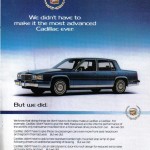Print advertisers – in fact, anyone who presents information in textual format – uses certain “artistic” elements to help get the point across. These elements include using pictures, slogans, typography, sizing, and position on the page to “argue” a certain point, which may not be directly stated. We have already looked at the video format of advertising. Today we will look at the print format.
NEW CONCEPTS AND VOCABULARY
Include the following vocabulary in your vocabulary notebook, and the notes in your journal:
Format is, simply, the type of advertisement (print, video, audio, etc.).
Structure is the arrangement of images and words.
Textual features are the ways in which writing is displayed or organized in an advertisement. This may include:
Bold, italicized, or underlined words to draw the audience’s attention.
- Bulleted lists to give quick bits of information.
- Numbered lists to show the order of importance.
ACTIVITIES
First, you will practice analyzing a few ads with the teacher.
Then, analyze the text features of the ads below using the following frames, also provided on your graphic organizer from the teacher:
The ______________ advertisement uses predominantly the ________________ appeal(s) by the way it_______________.
The advertisement’s claim is ___________________. The claim is supported by the ______________________. However, the ad uses the ____________________fallacy because _________________.
The advertisement uses the ______________ format to _______________. It uses the (tell about a feature the ad uses) in order to ___________________________. It also uses the (tell another feature) to _____________________.
YOU CAN CLICK ON EACH AD TO MAKE IT BIGGER.
After analyzing the ads,
NOW WRITE.
CREATE A 5-SENTENCE PARAGRAPH ABOUT EACH AD WHICH BEGINS WITH A SPECIFIC TOPIC SENTENCE USING THE FRAMES YOU JUST COMPLETED. ( For example, “The advertisement about animal tests for cosmetics uses the (ethos, pathos, or logos) appeal to make a claim, but the ad also contains the (name it) fallacy.”)
USE YOUR IDEAS ABOUT APPEAL, CLAIM, AND FALLACY TO CREATE THE DETAIL SENTENCES IN YOUR PARAGRAPHS.
THEN WRITE A CLINCHER SENTENCE, “IN CONCLUSION, . . .”, FOR EACH PARAGRAPH.
PROJECT
Create/build three original print ads using cutouts from the magazines on the table, printouts from my computer, or drawings. Make one ad using ETHOS, one using PATHOS, and one using LOGOS. At least one ad must contain a fallacy.
Glue down the cutouts on 11×17 paper, and arrange them together with lettering to complete the ad and send your message. Consider all of the textual features in your notes: what will be big? What will be small? What will stand out? Where will the strong color go? Create one “Analyzing” sheet for each of the three advertisements you create.



